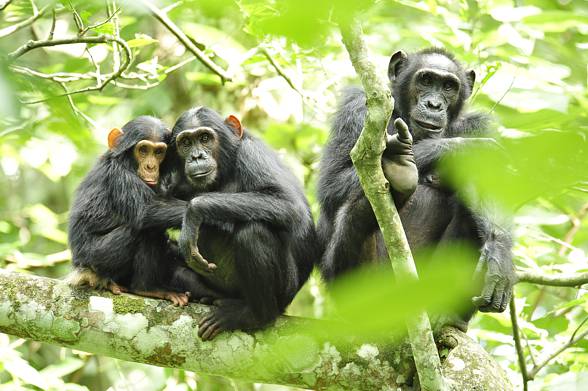Chimpanzees (chimps)
4% – that’s exactly the difference between chimpanzees and humans. Our DNA is the same in 96% (some studies suggest that even in 98.8 %!). Chimpanzees are physically and emotionally similar to humans. Despite the differences, we come from one ancestor, and this obliges us to treat chimpanzees with respect as they are our older cousins.
Classification
- Class: Mammals
- Subclass: Viviparous mammals
- Infraclass: Placentals
- Order: Primates
- Family: Hominidae
- Subtribe: Panina
- Genus: Pan
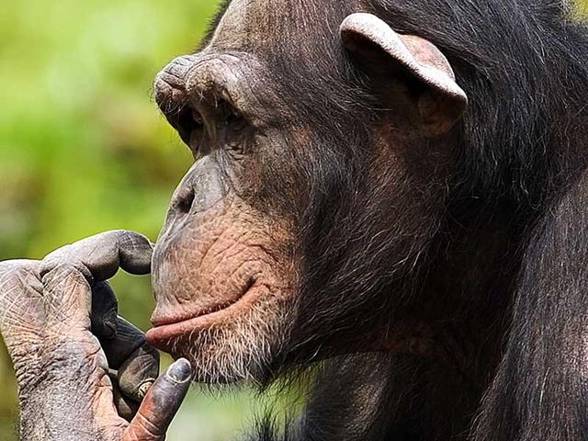
Occurrence
The genus chimpanzee is divided into two main species: Common chimpanzee (Pan troglodytes), which occurs in the western coast of central Africa, and Bonobo chimpanzee (Pan Paniscus), which can be found in the forests of the Democratic Republic of Congo (southern Congo River basin ). Congo River constitutes the border between the habitats of these two species.
Chimpanzee’s DNA vs. human DNA
Every few years or months we are surprised to hear about the differences and similarities between humans’ and primates’ chromosomes and the DNA construction. Over the past decade, research has shown a similarity of 98.8%, 95%, 96%, 86-89%, and a recent research by Jeffrey P. Tomkins (Institute for Creation Research, Texas, USA) suggests that it is only 70%.
As more and better research methods are emerging, further reports and numbers can be more accurate. Today we are not sure to what extent the chimpanzee’s and human’s DNA may be similar.

Characteristic
Appearance
The genus Chimpanzee (both Bonobo and Common chimpanzee) have common features when it comes to the appearance. Common chimpanzee has long arms. The total length of both its limbs constitutes approximately 1.5 length of whole its body. The upper limbs are longer than the lower limbs. Bonobo is smaller, but with proportionally longer limbs. Its silhouette is more erect than this of a Common chimpanzee.
Like a majority of apes, chimpanzees also use their strong long arms to climb trees. They usually move on the ground on four limbs, bending the palm of the hand in order to support it. Their feet are resistant to injuries and better adapted to walking than Orangutan’s, which is another representative of the hominids (Pongo). A chimpanzee has shorter toes and broader soles, what makes it easy for it to move while walking.
Both Common chimpanzee and the Bonobo can move objects while standing in an upright position.
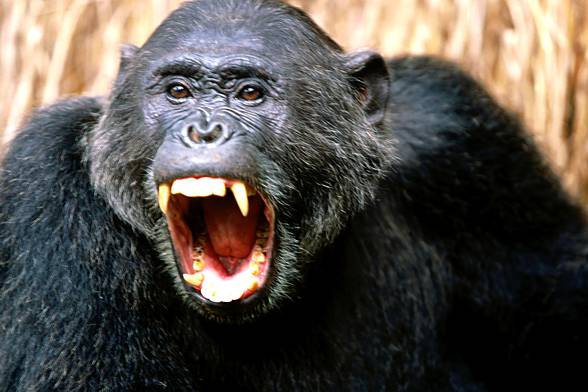
The coat is dark (black). On the face, hands and soles the color darkens with age and moreover, there is no hair. The chimpanzee does not have a tail. In juveniles, these body parts are pink and become graphite / black over time.
Although the jaw is clearly prominent, the mouth becomes fully visible only when the chimp curls it.
The human brain is about 3 times larger than the chimpanzee’s brain. It has a volume of 1200-1400 cm3, while the chimpanzee’s brain is between 300 and 500 cm3.
In comparison to the Gorilla, Chimpanzee has huge testicles. The first testicle weighs about 110 grams (0.24 lb), while gorilla’s weighs 28 grams (0.06 lb). To compare, human testicle’s weight does not exceed 43 grams (0.09 lb). The large size of the Chimpanzee’s testicles is determined by its sexual behavior during mating. Males try to fertilize as many females as possible, therefore they must have a large sperm count so that rivals have less chance of leaving their offspring.
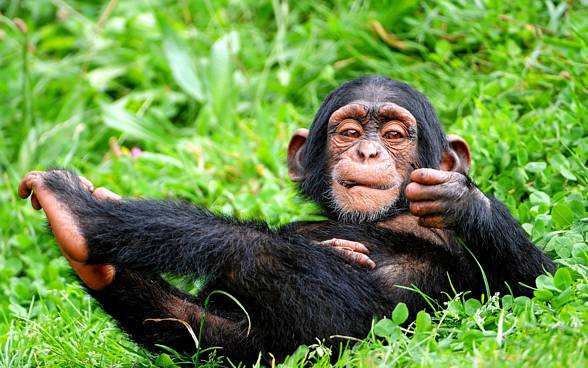
Behavior and sexuality
The Common chimpanzee is omnivorous, while the Bonobo feeds mostly on fruit. The Common chimp leads an open and active sex life. Sex is an inherent part of their everyday life. It constitutes a form of conflict resolution.
Chimpanzees live in male and female flocks called communities. Within communities, there is a hierarchy dictated by an individual position and influence on other members of the group. The highest in a hierarchy is an alpha male, who controls the group and keeps the order during disputes. The alpha male does not have to be the biggest and the strongest in the community. More important is that it has a kind of ”charisma” which influences the behavior of the rest of the group
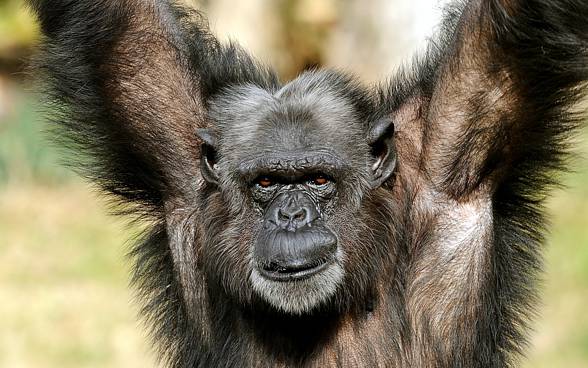
A male wishing to dominate gains “popularity” by gathering allies which support its efforts to take leadership. The alpha male regularly emphasizes its position, curling the body to seem bigger and more aggressive. It is easier for him to maintain power by intimidating other members of the community. Males, which are lower in the hierarchy, show their serfdom through the body language. The females show respect for the male alpha by presenting their rumps.
A hierarchy occurs as well among females. Sometimes, the daughter of the most important female “inherits” her position in the community. The females, just like the males, fight for power and seek allies among females of lower rank. However, males and females have different goals to achieve through gained power. The dominant male can fertilize many females and emphasize their position through the brutal treatment of its confreres. Females through domination gain access to many resources, such as food. Higher rank individuals have priority in accessing food. One goal is common for both sexes – they improve their living standards thanks to a high status.
Females usually choose a male alpha. Firstly, it must gain their support in order to become one. The females must be sure that under its guidance they will be helped to find the areas rich in food. It is possible that an alpha male is degraded by dominant females because they have determined that a particular individual does not meet their expectations. Then, they show their approval to another male in which they see the potential leader.
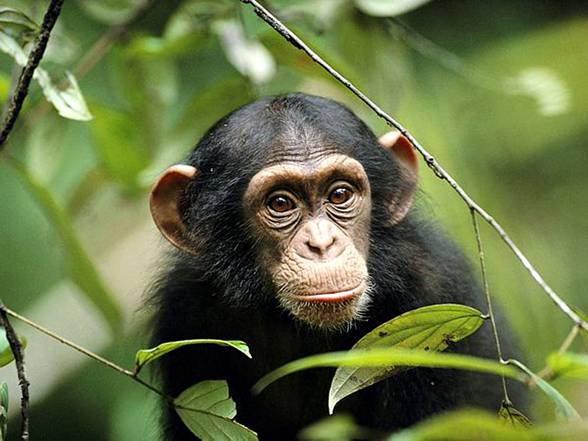
Human-like behavior
Intelligence
It has been noted that chimpanzees are able to create tools and use them while gaining food. They have complex hunting strategies that require cooperation and the power to influence other individuals. They are capable of cheating and manipulating. They are able to learn how to use symbols and understand the basics of human language. To some extent, they can also make plans.
Tools created by chimpanzees are used to dig up the termite mounds. The chimpanzee “catches” termites by inserting the stick into the mound and then pulling it “stuck” with insects.
An interesting discovery has been made that chimpanzees can create tools similar to spears.
They also build aboveground nests (using tools), tying branches of one or several trees together. This is an important skill especially for females, which make nests, especially for the juveniles. In the nest, there are soft branches and leaves. They are built on trees with a trunk diameter of at least 5 meters (16.4 ft). The nests are hanging from 3 to 45 meters (9.8 – 148 ft) high. Building takes place both during the day and at night.
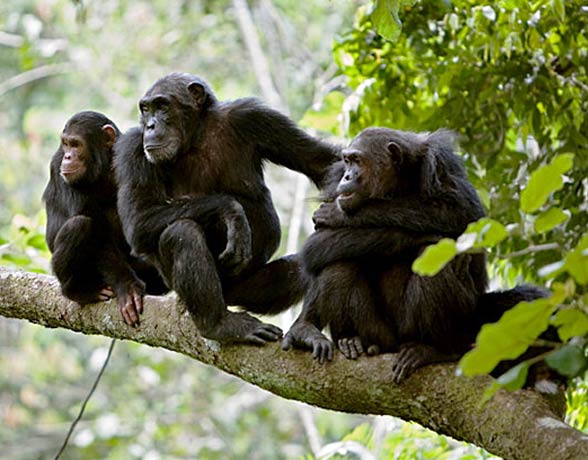
Emotions and feelings
It has been proven that while forming groups, chimpanzees are governed by the altruism. A chimpanzee from one community is indifferent to the harm done to an individual from another group. It is common for females and males to embrace orphaned babies from other flocks, however, they are often killed. They usually co-operate, especially during a patrol or while searching for food, etc.
Chimpanzees have their own, broadly understood spirituality. They mourn, they as well sort of fall in love, they can also perform a so-called rain dance. They admire the beauty of the surrounding world, such as the sunsets. They are interested in other animals and they treat them with respect. It was not uncommon to observe altruism in relation to smaller animals, such as feeding turtles. They understand the play in “pretending” – they give to inanimate nature (e.g. rocks) characteristics of animated nature by hugging and caressing.

Communication
Chimpanzees communicate with each other in similar ways as humans. They communicate non verbally, vocalizing (laughing), gesticulating and using facial expressions. During communication activates the area of the brain, which in humans’ brains is responsible for speech.

Reproduction
The strict mating period does not exist. Like in the case of humans, the reproduction of chimpanzees continues throughout the year. The females are fertile every 35 days. They reach their sexual maturity when they are 7-8 years old, however, the female may have its first litter at the age of 13. In spite of their interest in sexuality, males also start sexual activity at the age of 13.
The females copulate with several males. It happens that a male and a female create a pair only copulating with each other.
The pregnancy lasts about 230 days. One or two juveniles are born within one litter. A young chimpanzee is already fully developed but weak and defenseless. At first, the mother carries it on her shoulders and then attaches it to the hair on her belly. At 5 months old, the juveniles take a seat on the back of their mothers. Breastfeeding lasts up to 3 years. Until achieving sexual maturity (up to 10 years old), the young are being taken care of by the females.

Detailed information / dimensions
Common chimpanzee, robust chimpanzee (Pan troglodytes)
- Height:
- Male: up to 170 cm (67 in)
- Female: up to 130 cm (51 in)
- Weight:
- in the wild:
- Male: up to 40 kg (88 lb)
- Female: up to 30 kg (66 lb)
- in captivity:
- Male: up to 90 kg (198 lb)
- Female: up to 80 kg (176 lb)
- Lifespan:
- 40-45 years in the wild
- in captivity about 50 years.
Bonobo, dwarf / gracile chimpanzee (Pan paniscus)
- Height: 100 – 120 cm (39 – 47 in)
- Weight:
- Male: 34 – 60 kg (75 – 132 lb)
- Female: 30 kg (66 lb)
- Lifespan: up to 40 years in captivity, unknown in the wild

Chimpanzee – curiosities
- In Bonobo sexuality plays a very important role when it comes to the functioning in the community – it is a form of greeting, reconciliation and privilege. They also kiss each other and practice face-to-face sexual positions (such practices occur only in humans).
- Male flocks are very aggressive. The Common chimpanzee is a territorial animal that often kills other chimpanzees.
- The common chimpanzee is more aggressive than the Bonobos, which does not seem to have such behavior.
- In captivity, the chimpanzee sleeps about 9 hours a day.
- The human brain is 3 times larger than the chimpanzee’s brain.
- Chimpanzees respond with laughter at social behaviors such as tickling, chasing, or other types of plays.
